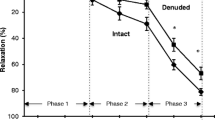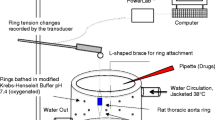Summary
Isometric force development was measured in isolated ring segments of dog left anterior descending coronary artery to K+ (10–70 mM), U-46619 (0.3–30 nM), endothelin-1 (0.1–30 nM), 5-HT (0.1–30 μM) and angiotensin-II (0.1–30 nM), Compared with the maximum tissue response to a K+ depolarizing solution (100%) there was a marked variation in the maximum response to each spasmogen: K+ (111%), U-46619 (85%), endothelin-1 (48%), 5-HT (49%) and angiotensin-II (15%). In arteries pretreated with cromakalim (0.3–10 μM) the maximum response to all constrictor agents (with the exception of K+) was reduced but the potency was unaffected. Maximum responses to angiotensin-II and 5-HT were affected at concentrations approximately threefold lower than those to endothelin-1 and U-46619. Removal of the endothelium increased the maximum response caused by 5-HT and reduced the potency of cromakalim in inhibiting this contraction. Glyceryl trinitrate and sodium nitroprusside were 100–1000 times more potent than cromakalim although they produced qualitatively similar effects.
Cromakalim is an effective spasmolytic against a number of vasoconstrictors in the dog coronary artery. No marked spasmogen selectivity could be identified for Comakalim that was not shown by glyceryl trinitrate or sodium nitroprusside.
Similar content being viewed by others
References
Angersbach, D, Nicholson CD (1988) Enhancement of muscle blood cell flux and pO2 by cromakalim (BRL 34915) and other compounds enhancing membrane K+ conductance, but not by Ca2+ antagonists or hydralazine, in an animal model of occlusive arterial disease. Naunyn-Schmiedeberg's Arch Pharmacol 337:341–346
Angus JA, Broughton A, Cocks TM, Wright CE (1989) Coronary circulation and 5-HT. In: Saxena PR, Wallis DI and Bevan P (eds) Cardiovascular pharmacology of 5-HT. Kluwer, Dordrecht, pp 363–378
Angus JA, Cocks TM (1989) Endothelium derived relaxing factor. Pharmacol Ther 41:303–351
Bray KM, Newgreen DT, Small RC, Southerton JS, Taylor SG, Weir SW, Weston AH (1987) Evidence that the mechanism of the inhibitory action of pinacidil in the rat and guinea pig smooth muscle differs from that of glyceryl trinitrate. Br J Pharmacol 91:421–429
Buckingham RE (1988) Studies on the anti-vasoconstrictor activity of BRL 34915 in spontaneously hypertensive rats; a comparison with nifedipine. Br J Pharmacol 93:541–552
Chi L, Uprichard ACG, Lucchesi BR (1990) Profibrillatory actions of pinacidil in a conscious canine model of sudden coronary death. J Cardiovasc Pharmacol 15:452–464
Cocks TM, Angus JA (1983) Endothelium-dependent relaxation of coronary arteries by noradrenaline and serotonin. Nature 305:627–630
Cook NS, Hof RP (1988) Cardiovascular effects of apamin and BRL 34915 in rats and rabbits. Br J Pharmacol 93:121–131
Gillespie JS, Sheng H (1988) The lack of involvement of cyclic nucleotides in the smooth muscle relaxant action of BRL 34915. Br J Pharmacol 94:1189–1197
Hamilton TC, Weir SW, Weston AH (1986) Comparison of the effects of BRL 34915 and verapamil on electrical and mechanical activity in rat portal vein. Br J Pharmacol 88:103–111
Hof RP, Quast U, Cook NS, Blarer S (1988) Mechanism of action and systemic and regional hemodynamics of the K+ channel activator BRL 34915 and its enantomers. Circ Res 62:679–686
Hollingsworth M, Amedee T, Edwards D, Mironneau J, Savineau JP, Small RC, Weston AH (1987) The relaxant action of BRL 34915 in rat uterus. Br J Pharmacol 91:803–813
Maruyama M, Faber N, Gross G (1989) Effect of the new potassium channel activator, END 52692, on coronary collateral blood flow in anaesthetized dogs (abstract 3894). FASEB J 3:A897
McPherson GA, Angus JA (1990) Characterization of responses to cromakalim and pinacidil in smooth and cardiac muscle by use of selective antagonists. Br J Pharmacol 100:201–206
Videbaek LM, Aalkjaer C, Mulvany M (1988) Pinacidil opens K+-selective channels causing hyperpolarization and relaxation of noradrenaline contractions in rat mesenteric resistance vessels. Br J Pharmacol 95:103–108
Wallenstein S, Zucker CL, Fleiss JL (1980) Some statistical methods useful in circulation research. Circ Res 47:1–9
Weir SW, Weston AH (1986) Effect of apamin on responses to BRL 34915, nicorandil and other vasorelaxants in the guinea-pig taenia caeci. Br J Pharmacol 88:113–120
Author information
Authors and Affiliations
Additional information
Send offprint requests to G. A. McPherson at the above address
Rights and permissions
About this article
Cite this article
McPherson, G.A., Keily, S.G. & Angus, J.A. Spasmolytic effect of cromakalim in dog coronary artery in vitro. Naunyn-Schmiedeberg's Arch Pharmacol 343, 519–524 (1991). https://doi.org/10.1007/BF00169555
Received:
Accepted:
Issue Date:
DOI: https://doi.org/10.1007/BF00169555




